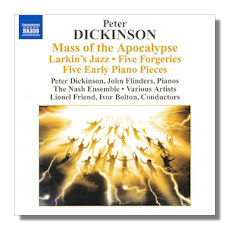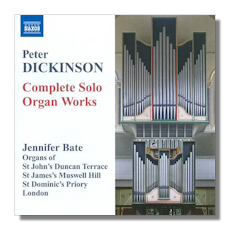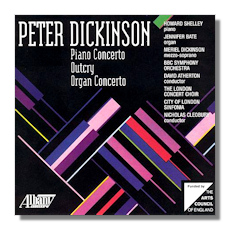
The Internet's Premier Classical Music Source
Related Links
- Dickinson Reviews
- Latest Reviews
- More Reviews
-
By Composer
-
Collections
DVD & Blu-ray
Books
Concert Reviews
Articles/Interviews
Software
Audio
Search Amazon
Recommended Links
Site News
 CD Review
CD Review
Peter Dickinson

- Mass of the Apocalypse (1984) *
- Larkin's Jazz
- Five Forgeries for Piano Duet
- Five Early Pieces for Solo Piano
- Air for Solo Flute
- Metamorphosis for Solo Flute
- Lullaby from "The Unicorns"
* Rev. Donald Reeves, speaker
* Jo Maggs, soprano
* Meriel Dickinson, mezzo-soprano
* James Holland and David Johnson, Percussion
* John Alley, piano
* St. James Singers/Ivor Bolton
Peter Dickinson, piano
John Flinders, piano
Duke Dobing, flute
Henry Herford, baritone-speaker
Nash Ensemble/Lionel Friend
* Live analog recording, 1988
Naxos.8.572287 79:01


Complete Solo Organ Works
- A Cambridge Prelude
- Prelude
- Postlude on Adeste Fidelis
- Preludes on Songs 20, 34, 46 by Orlando Gibbons
- Toccata
- Meditations on "Murder in the Cathedral"
- Study in Pianissimo
- Dirge
- Three Statements
- Carillion
- Paraphrase I
- Blue Rose Variations (dedicated to Jennifer Bate)
- Millenium Fanfare
Jennifer Bate, organ
Naxos 8.572169 77:42


- Piano Concerto
- Organ Concerto
- Outcry - A Cycle of Nature Poems for Contralto Solo, Chorus & Orchestra *
Howard Shelley, piano
Jennifer Bate, organ
BBC Symphony Orchestra/David Atherton
* Meriel Dickinson, mezzo-soprano
* London Concert Choir,
* City of London Sinfonia/Nicholas Cleobury
Albany Records TROY360 77:35
Peter Dickinson (b. 1934), a British musician and scholar whose centennial book on Samuel Barber I reviewed earlier this year (Samuel Barber Remembered - A Centenary Tribute) has had a musical career of extraordinary breadth. He acquired his strong interest in American music, in the course of the three years, from 1958, which he spent in New York early in his career. During that time he studied at Juilliard with Bernard Wagenaar, and met American composers including Cage, Carter, Cowell, and Varese. He also worked as performer and critic, and subsequently published books on Cage, Copland, Lennox Berkeley and Lord Berners. Clearly this shows a very broad appreciation of different styles, evident on the recordings in review. Dickinson's academic career included teaching at Fairleigh Dickinson University, the University of Birmingham, the University of London, where he was head of Music at the Institute of United States Studies, and Keele University, where he established a Centre for American Music. He is now emeritus at Keele and London.
Dickinson's first appointment was as Organ Scholar at Queens College, Cambridge University where he was particularly drawn to the organ works of Bach. He now reveals that when he was a prefect, he would sometimes feel free to play the chapel organ in the night in his dressing gown, and that his father had been a church organist, so clearly, his interest in organ music goes back a very long way. He is also a pianist.
The Albany recording of his Organ Concerto, Piano Concerto and Outcry is not recent. Originally released by EMI and then deleted from their catalog, this recording happily was taken up by Albany Records a decade ago. My motive for reviewing it now is three-fold. First, I find it a tremendously exciting CD. Second, its inclusion of the Organ Concerto adds depth to the understanding of Dickinson's solo organ music CD. (Unfortunately it does not also include the composer's Concerto for Violin; his three concertos comprise his works with full orchestra – and even these use the orchestra sparingly. Third, my inclusion of this disc should provide a fuller introduction to this very interesting composer, whose work is not well known in North America, even though he has devoted much of his career to American music. The music on this disc has an enormous range of musical elements, sometimes with simultaneous use of more than one type of music, something he credits to Cage, and their form is unusual. The two concertos are each played without pause but the recording designates thirteen bands for the piano concerto and nine bands for the organ concerto. Both are fascinating and very unusual. The dynamic range is enormous, though very slow and quiet music is predominant. The stylistic range is also extensive.
The Piano Concerto (1984) has three different thematic sources, Dickinson tells us in his very helpful notes, which permit one to follow the music formally. The themes include a dirge and a blues theme taken from a work by Dickinson called Extravaganzas, and a rag develops out of one of the themes. But the themes are less interesting than the rhythms, the dynamics and the pacing. Four of the thirteen sections are adagio or lento; one is described as "a frozen pianissimo, another is "Tranquillo" and the last is "Absolutely tranquil." Some of the slow quiet parts are hushed, mysterious-sounding, even sublime, like the slow music Bartók called "religioso." At the other extreme there is some heavy percussion with brass. The work strikes me as rather like some kind of a very slowly unfolding musical story, beginning with a quiet statement by the piano interrupted by a brief slashing attack by the orchestra reminiscent of Sacre du printemps. An increasingly tense rising and falling passage for the horns over the tinkling piano (the dirge) rises to a loud crescendo; the third variation of the dirge is close to terrifying, and the subsequent adagio contains a moment my notes call a "shriek." There are some changes of pace. At one point an upright piano is heard with a rag, but the featured piano "distorts the harmony and picks out fragments, increasingly taking control." Fascinating.
Outcry (1969) is a much more straightforward work, which Dickinson calls "a protest against cruelty to birds and animals expressed through settings of poems" by Blake, Hardy and John Clare, the texts of which are included. The songs are eloquent, heartfelt, and beautiful. The mezzo-soprano in this performance is Peter Dickinson's sister (with whom he also collaborated in a recording of works by Satie.) Dickinson likens his settings to parts of the mass, "but as a kind of black mass" in one case: one poem by Clare is a horrifying account of badger-baiting. The musical character of the songs is varied. The opening number begins quietly but leads to a crashing crescendo (and the movement ends that way too.) High voices enter slowly, then are accompanied with percussion. A solo by the mezzo, a pause, and more by the choir follows. In contrast, Hardy's "The Blinded Bird," a quiet and melodic lament by the soloist and then the choir, is lightly accompanied. The treatment of "Horses Aboard," about horses being sent off to assist in war, is similar. "The Badger" by Clare has some savage music and a loud whistle. The chorus is loud, but at one point the singing reminded me of Britten, and the spirit of the whole piece is perhaps akin to that composer's "Our Hunting Fathers." Dickinson's final setting – of Clare's hymn – departs from the cruelty theme and proclaims the value of love; its manner is declamatory and it ends loudly.
The Organ Concerto (1971) I find thrilling to listen to, and it contains many unusual effects. Most of it is very slow – two thirds of the sections are marked adagio or grave – but it grabs the attention immediately with loud blasts from the organ. Dickinson, in his notes, says that the third loud organ chord is in "C major, which is slowly distorted into a tone-cluster." He also informs us that the concerto has a single thematic source, his own bluesy setting of Byron's lyric, "So we'll go no more a'roving," and it uses harmony borrowed from Ravel's Valse noble et sentimentales. (I wonder if anyone could have guessed this!) Soft drumbeats with quiet strings and brass, a rapid passage for woodwinds followed by a four-minute hushed sequence like the one in the piano concerto which I compared to Bartók, follow. In this one a tinkly celesta is heard over the melody for strings. There is a duet for two timpani, "rapid exchanges between organ pedals and brass," and a flute solo. A dramatic buildup becomes very loud with a sustained roar from the organ. Reversing what happens at the outset, the organ's tone cluster "slowly thins out to C major, only for the King of Instruments to be obliterated by four percussionists," and ends with a crash of cymbals. A moment of silence is followed by clarinet and English horn solos against an organ cadenza. The final grave is quiet and reverses the roles of the strings and organ in the opening grave. The celesta has the last soft word.
Most of the solo organ works are from early in Dickinson's career, so are quite different from his organ concerto. The performance is by the same, highly distinguished organist, Jennifer Bate, who has received a number of British and international honors, including an honorary doctorate, Fellowship in the Royal Society of Arts, and an OBE. She performs here on three instruments located in London. Dickinson's solo organ pieces are presented on this CD pretty much in the order of composition, and half of them are short and composed when the composer was young. The earliest, the Cambridge Postlude, was composed when Dickinson was nineteen and an Organ Scholar at Queens College, Cambridge. It is quite nice. The Preludes on Songs of Orlando Gibbons coincided with the beginning of the early music revival and have never been published. The 1955 Toccata was written for a brilliant organist at Queens; never played by Dickinson, it was revived by Bate in 1982. Meditations on Murder in the Cathedral (1958) was a reworking of incidental music for Eliot's play performed where Dickinson was teaching. He describes the result as a "kaleidoscopic piece that juxtaposes a kind of sensual hymn with moments of violence." 1958 was the year Dickinson went to New York, as mentioned, and subsequent works departed stylistically from the early works as a result. Study in Pianissimo, written in America, uses some serial techniques. Three Statements are improvisatory and include both wide melodic leaps and tone clusters. Carillion, as the title suggests, gives us bell sounds, but in variable meters, with "rhythms rarely heard from church steeples perhaps but developed from them just the same." Dickinson first played it at a wedding.
There are two pieces of significant (quarter hour) length here, written eighteen years apart (1967 and 1985). Paraphrase I is in ten sections and originated in a motet by the composer. Blue Rose Variations, written after the organ concerto, I find the most interesting work in this collection. The title comes from Dickinson's piano transcription of MacDowell's To a Wild Rose into a blues and a classical rag. The variations combine these two forms. The final organ piece, Millenium Fanfare, intersperses the organ chords from the beginning of the organ concerto with trumpet passages.
The other Naxos recording is billed as a presentation of Dickinson's "style modulation," but also includes some lovely short pieces for flute. The long pieces, Mass of the Apocalypse" and Larkin's Jazz, alternate spoken words with music, in a manner somewhat comparable – especially Larkin's Jazz – to a recent work by another British composer, John McLeod, Haflid's Pictures: Twelve Aphorisms for Piano (Priory PRCD1018), which I reviewed earlier.
Mass of the Apocalypse (1984), commissioned for the 300th anniversary of St. James Church, Piccadilly, is written for four part chorus, soprano and mezzo-soprano soloists, speaker, two percussionists and piano. Readings are from the King James Version of the Book of Revelation; the sung passages are from the 1980 Alternative Service Book, which uses contemporary language. The spoken words are loud and clear. The sung parts tend to yield to the percussion, which is strikingly appealing. The chorus initially enters quietly but gathers force. In the Sanctus and Benedictus there is a driving beat and the chorus is louder and faster than before. In the Agnus Dei the tune is adopted from Palestrina and sounds like a vocalise to my ears. The Gloria is naturally upbeat and the Ite Missa Est dismissal is lovely, with a soft steady beat on the marimba and tam-tam, soft vocalise singing and a warm sound., which dies away at the end.
Larkin's Jazz was written in honor of the poet Philip Larkin, who in fact loved jazz. Four poems are read clearly (fortunately, as no texts are provided) by a speaker, preceded by a brief musical prelude and followed by a musical commentary. Sidney Bechet's Blue Horizon and King Oliver's Riverside Blues gave Dickinson musical material for the whole piece. Instrumentation is for flute, doubling piccolo and alto flute; Bb clarinet, doubling bass clarinet; Bb soprano saxophone (offstage), Bb trumpet, cello, piano and percussion, as well as speaker/baritone, some of whose commentary is sung. Tempos, moods and dynamics are varied. The result of all this is quite successful, to my mind.
The Five Forgeries for piano duet were intended as "party pieces," Dickinson says. Each is dedicated to a particular person and each parodies aspects of the style of different composers, namely Poulenc, Hindemith, Stravinsky, Delius and Bartók. I find the firmness of the Hindemith, the gentleness of the Delius and the staccato of the Bartók more convincing than the rhythm of the Stravinsky or the Poulenc, which would be in his lightest vein. The Five Early Pieces for solo piano date from Dickinson's final year at Cambridge. The third of these is especially appealing.
I can recommend all of these recordings but it will be obvious that I was most taken with the Albany one, which I cannot recommend highly enough.
Copyright © 2010, R. James Tobin





















